The maximum dose of propranolol for anxiety is usually between 120 mg and 160 mg daily. But individual limits vary based on medical history, symptom severity, and treatment response. Healthcare providers determine the appropriate maximum doses through careful evaluation and monitoring. Going over these limits can cause serious side effects. You may experience a dangerously low heart rate or low blood pressure.
Knowing how to dose propranolol lets patients discuss their anxiety treatment choices with healthcare providers. This medication functions distinctly compared to traditional anxiety drugs. It targets physical symptoms instead of emotional responses. This makes proper dosing crucial for safety and effectiveness.
This article is for educational purposes only. It is not medical advice. Always consult qualified healthcare professionals before starting, stopping, or changing any medication. Dosing decisions should be made under medical supervision, taking into account individual health circumstances and specific needs.
What Is Propranolol?
Definition and Mechanism of Action
Propranolol is a type of medicine known as a beta blocker. It falls under the category of beta-adrenergic blocking agents. The medication blocks beta receptors in the body. Adrenaline and noradrenaline, which are stress hormones, influence these receptors. They cause many physical symptoms of anxiety.
When stress or anxiety arises, the body's fight-or-flight response is activated. Adrenaline causes quick reactions. You may feel your heart racing, shaking, or sweating. Propranolol blocks beta receptors. This stops adrenaline from binding and triggering physical responses. This mechanism makes propranolol particularly effective for managing the physical manifestations of anxiety.
The drug was first developed in the 1960s for heart issues. It is still FDA-approved for primarily cardiovascular uses. Patients noticed its calming effects while taking it for heart issues. They felt less anxious in stressful moments. This led to its off-label use for managing anxiety.
Common Medical Uses Beyond Anxiety
Propranolol treats various medical conditions beyond anxiety management. Medications for physical issues can also help with mental health symptoms. Understanding psychiatric disorders highlights this connection.
The FDA has approved propranolol for several uses. It treats high blood pressure, controls irregular heart rhythms, and prevents migraine headaches. It also reduces tremors and manages certain types of chest pain. Doctors may prescribe it for thyroid storm, a serious thyroid condition. They may also use it to prevent bleeding in people with liver disease.
These diverse applications show propranolol's wide-ranging effects on the body's stress response system. The mechanism that controls heart rate and blood pressure also manages anxiety symptoms.
How It Manages Physical Anxiety Symptoms
Propranolol focuses on the physical symptoms of anxiety. It does not address the emotional or psychological aspects. When anxiety strikes, it can slow your heartbeat. It may stop your hands from shaking, reduce sweating, calm a shaky voice, and prevent blushing.
This targeted method makes propranolol great for performance anxiety. It helps in stressful situations, like public speaking, test-taking, job interviews, and more. People with physical anxiety symptoms usually find propranolol more helpful. In contrast, those whose anxiety shows up as worry or racing thoughts may not benefit as much.
The medication doesn't change mood, thoughts, or how anxiety feels. You might still feel nervous in your mind, even if your body feels calm. Many people find this helps them handle stress better.
Propranolol for Anxiety: How It Works
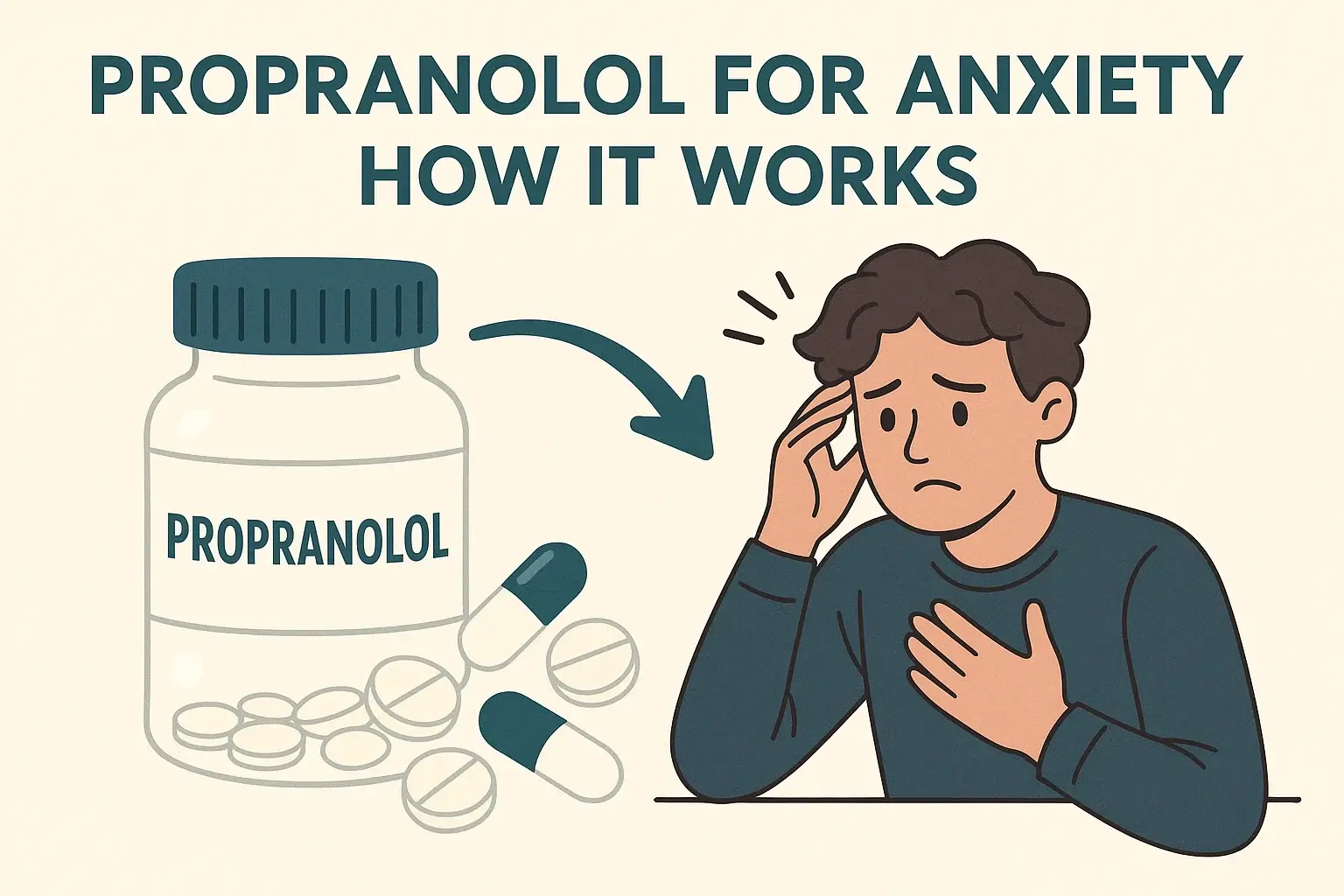 Role of Propranolol in Blocking Beta Receptors
Role of Propranolol in Blocking Beta Receptors
Beta receptors are found all over the body. They are mainly present in the heart, blood vessels, lungs, and other organs. The two main types are beta-1 receptors and beta-2 receptors. Beta-1 receptors are primarily in the heart. Beta-2 receptors are in the lungs and blood vessels. Propranolol blocks both types. This explains its therapeutic effects and possible side effects.
When adrenaline cannot bind to these receptors, several physiological changes occur. Heart rate slows and becomes steadier. Blood vessels relax a bit, lowering blood pressure. Tremors fade as muscle tension eases. This interrupts the cycle of physical stress responses.
This blocking action occurs quickly, typically within 30 to 60 minutes after taking the medicine. The effects last for several hours. This depends on whether you take immediate-release or extended-release formulations. So, timing is key for handling specific anxiety-provoking situations.
How It Reduces Physical Symptoms Without Altering the Emotional State
Propranolol works differently from medications that change brain chemistry. It primarily targets beta receptors in the body, rather than in the central nervous system. It explains how it helps with physical symptoms. However, it doesn't impact thoughts, feelings, or the mental side of anxiety much.
The medication won't sedate you or alter your mind like benzodiazepines can. You maintain complete alertness and cognitive function despite experiencing reduced physical symptoms. This distinction makes propranolol appealing for situations requiring mental clarity alongside anxiety management.
Some people find that reducing physical symptoms creates a positive feedback loop. When your heart is calm and your hands are steady, you might feel less anxious. However, propranolol doesn't treat the underlying anxiety disorder itself, only the physical manifestations.
Difference Between Propranolol and Typical Anti-Anxiety Medications
Traditional anti-anxiety medications work through different mechanisms than propranolol. SSRIs, or selective serotonin reuptake inhibitors, boost serotonin levels in the brain. This process takes weeks and helps improve mood and reduce anxiety. Benzodiazepines boost GABA activity. They help reduce anxiety effectively. However, they may cause sedation and can lead to addiction.
Propranolol offers distinct advantages and limitations compared to these options. It acts fast and doesn't cause sedation or cognitive issues. There's no risk of addiction or withdrawal. You can take it as needed, not every day. It only treats physical symptoms. It doesn't address underlying anxiety disorders. Also, it's not suitable for those with specific heart or lung conditions.
Learning to calm anxiety naturally offers helpful ways to manage it without medication. Choosing between propranolol and other anxiety meds depends on your symptoms, history, and goals.
Recommended Dosage Range for Anxiety
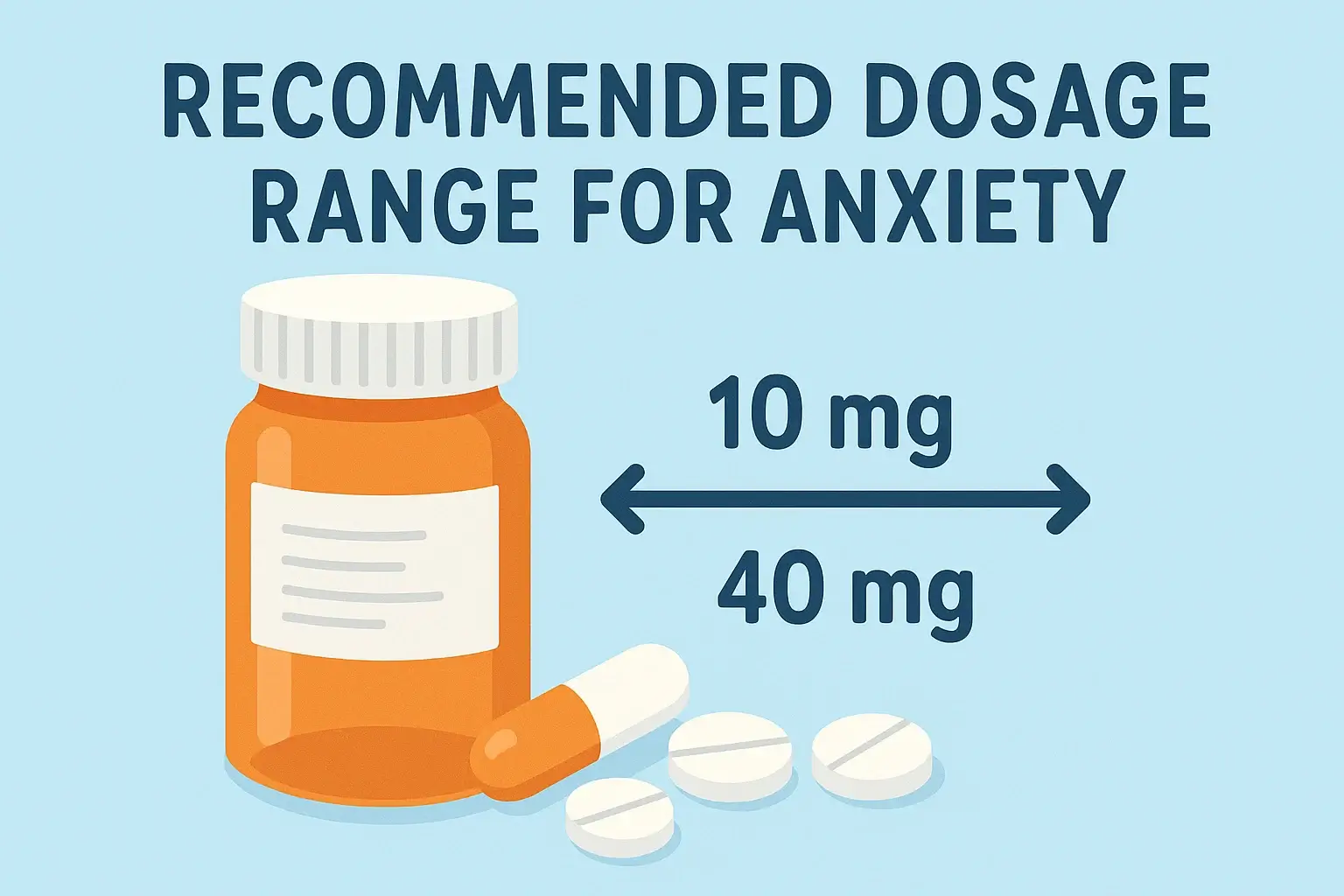 Typical Starting Dose for Anxiety Relief
Typical Starting Dose for Anxiety Relief
Healthcare providers often begin propranolol for anxiety at low doses. This helps them check tolerance and response. The usual starting dose is between 10 mg and 40 mg. Take it 30 to 60 minutes before facing situations that cause anxiety. Some providers start with 20 mg twice daily for general physical anxiety symptoms.
This careful approach helps track side effects and find the lowest effective dose. Many people respond well to lower doses, making higher amounts unnecessary. Starting low helps identify individuals who may be sensitive to beta-blockers.
The immediate-release formulation is often prescribed first. It offers flexible dosing and timing adjustments. Extended-release versions might be an option later for people who need daily help with anxiety symptoms.
Gradual Dose Increase Under Medical Supervision
If the first doses don't manage symptoms well, healthcare providers may gradually increase the amount. You usually add 10-20 mg at a time. Wait several days to a week before increasing again. This slow titration finds the lowest effective dose. It also checks for side effects.
Always increase doses under medical supervision. Regularly check heart rate and blood pressure. Healthcare providers check for symptom improvement, side effects, and treatment response before suggesting increases.
Some people find symptom control with 40 mg daily. Others might need 80 mg or more. The goal is to find the lowest dose that provides sufficient benefit while minimizing adverse side effects.
Variations in Dosage for Short-Term vs. Long-Term Management
Situational or performance anxiety often responds to as-needed dosing. People usually take 10 mg to 40 mg about an hour before stressful events. This includes activities such as presentations, performances, or social gatherings. This approach provides targeted symptom control without requiring daily medication.
Long-term anxiety management with propranolol usually involves taking it two or three times a day. This is for immediate-release forms. You can also take the extended-release version once daily. Daily doses for ongoing anxiety typically range from 40 mg to 120 mg. This total is divided throughout the day.
Situational and ongoing use affects dosing schedules and total daily amounts. Healthcare providers look at how often anxiety patterns occur, how predictable symptoms are, and what patients prefer when suggesting dosing schedules.
Factors Affecting Individual Dosage Needs
Age significantly affects propranolol dosing. Older adults usually need lower doses. Their metabolism changes, making them more sensitive to heart-related effects. Younger adults may require higher doses to achieve the same impact.
Body weight matters a bit for dosing, but propranolol isn't prescribed based on strict weight calculations like some other drugs. Larger people may need higher doses. Yet, how each person processes the drug matters more than size.
Symptom severity and frequency significantly influence dosing decisions. Mild, occasional symptoms may help with low doses as needed. In contrast, severe daily anxiety symptoms might need higher doses for better control.
Coexisting health conditions can significantly impact the safe administration of propranolol doses. Heart conditions, lung diseases, diabetes, thyroid issues, and liver or kidney problems affect how much propranolol is safe for someone to take. Spotting early signs of mental health issues helps identify when anxiety needs medical care and treatment.
What Is the Maximum Dose of Propranolol for Anxiety
Standard Upper Dosage Limits and Guidelines
The most significant daily dose of propranolol varies depending on the condition being treated. Most healthcare providers suggest keeping daily doses for anxiety at 160 mg or less.
This is a guideline, not a strict limit.
For comparison, propranolol dosing for other conditions reaches much higher amounts. High blood pressure treatment typically requires 320 mg to 640 mg of medication daily. For migraine prevention, the dose is often 80 mg to 240 mg daily. Tremor management generally needs 120 mg to 320 mg daily. Higher doses can help treat different conditions, but they need more medical monitoring than usual for anxiety management.
A lower maximum for anxiety indicates off-label use. It also shows that physical anxiety symptoms often respond well to moderate doses. Anxiety treatment usually lasts a long time. Therefore, safety is more important for long-term treatments.
Why Exceeding Recommended Doses Can Be Dangerous
Taking too much propranolol can cause severe and potentially life-threatening side effects. High doses can lead to serious issues. These include a slow heart rate (severe bradycardia), low blood pressure, and heart block. These issues can cause fainting, shock, or other dangerous heart rhythms. It can cause severe breathing problems, especially for those with asthma or lung issues.
Propranolol overdose can hide low blood sugar symptoms in people with diabetes. It may also cause confusion, unusual tiredness, or cold, numb limbs due to decreased blood flow. In severe cases, it can lead to dizziness or fainting.
The cardiovascular effects pose the most serious risks. Beta blockers reduce the heart's ability to respond to stress and physical demands. Too much medication can slow the heart. When this happens, the heart may not pump enough blood. This can lead to a medical emergency.
Importance of Individualized Treatment Plans
No universal maximum dose fits everyone. Healthcare providers need to review each person's complete medical history. This helps them set safe upper limits. A person with good heart health can manage higher doses better than someone with heart problems.
Some people manage their symptoms well on 40mg, but others need 120mg or more. Drug metabolism speed, receptor sensitivity, and anxiety symptom severity all play a role in these differences.
Regular medical supervision helps providers adjust doses. They do this based on how patients respond and watch for side effects. What works at first might need changes later. This can occur as circumstances change or the body becomes accustomed to the medication.
Monitoring and Follow-Up with Healthcare Professionals
Anyone taking propranolol for anxiety should have regular check-ins with their healthcare provider. Initial monitoring occurs frequently, typically every few weeks, when starting or adjusting doses. It involves checking heart rate and blood pressure. We also look for symptom improvement and evaluate side effects.
Once a stable and effective dose is established, monitoring can occur less frequently. However, annual check-ups should still include a cardiovascular assessment. Report any new symptoms, health changes, or concerns about the effectiveness of your medication to your healthcare provider immediately.
Healthcare providers should regularly assess whether propranolol remains the most suitable choice or if other options may be more effective. This ongoing review makes sure treatment meets the patient's needs safely and effectively.
How to Take Propranolol Safely
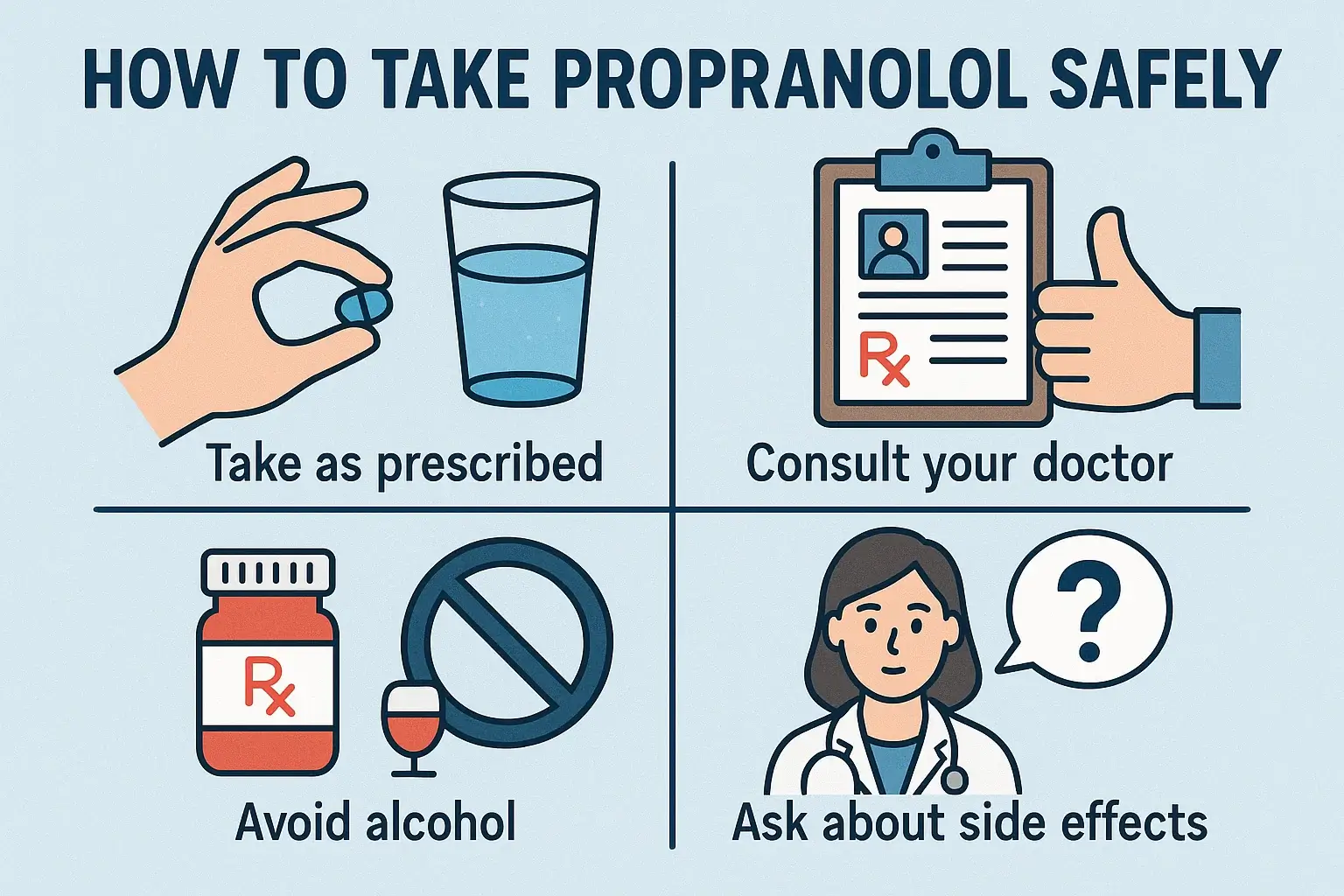 Proper Timing and Frequency of Doses
Proper Timing and Frequency of Doses
Propranolol is usually taken two to three times a day for anxiety. Its effects last about four to six hours. Extended-release formulations enable once-daily dosing, typically in the morning. Their effects last all day.
For situational anxiety, timing matters significantly. Take immediate-release propranolol 30 to 60 minutes before stressful events. This timing helps it work best. Planning ensures the medication reaches peak effect when you need it most.
Consistent timing for regular doses helps maintain stable blood levels and predictable effects. Taking medication at the same time each day enables you to remember your doses more easily. This routine also lowers the chances of missing a dose.
Taking Propranolol With or Without Food
Propranolol can be taken with or without food. However, having it with food may help prevent stomach upset for some people. Extended-release formulations must be swallowed whole. Do not crush or chew them. Crushing or chewing will release the full dose at once, rather than gradually.
Some people find that having a small snack with propranolol helps prevent lightheadedness. This is especially true when they first start the medication. Others experience no difference between taking it with or without food. Individual experimentation under the guidance of a healthcare provider helps determine personal preferences.
Avoid alcohol while taking propranolol. It can lower blood pressure more and raise your risk of dizziness or lightheadedness. Grapefruit juice affects propranolol levels. However, this interaction isn't as strong as with some other medications.
Missed Dose Instructions and Consistency Importance
If you forget a dose of propranolol for anxiety, take it as soon as you remember. But if the next dose is near, skip the missed one. If it is nearly time for the next dose, skip the missed one and resume your regular schedule. Never double the dose to make up for a missed one.
For as-needed dosing before events, take your dose as directed by your healthcare provider. Missing an as-needed dose doesn't need any makeup dosing.
Consistency matters for people taking propranolol daily for ongoing symptom management. Irregular dosing can lead to changes in blood pressure and heart rate. This might trigger rebound symptoms or make anxiety tougher to manage.
Why Self-Adjusting Doses Are Unsafe
Changing propranolol doses without medical guidance creates several risks. Increasing doses can lead to serious heart issues. If you stop or reduce propranolol suddenly, you may experience rebound effects. This can include a rapid heart rate, elevated blood pressure, and heightened anxiety.
Healthcare providers look at several factors when adjusting doses. These are things patients can't check on their own. Check heart rate response and blood pressure effects. Additionally, consult a healthcare professional about potential interactions with other medications. Cardiovascular health also requires evaluation.
If your doses aren't controlling symptoms or are causing side effects, contact your healthcare provider. Don't make changes on your own. They can safely change your treatment plan based on a comprehensive assessment.
Potential Side Effects and Risks
Common Side Effects at Therapeutic Doses
Fatigue is one of the most frequently reported side effects of propranolol. The medication can affect heart rate and blood circulation. This may lead to tiredness, especially when starting treatment or increasing the dose. Many people find this effect diminishes over several weeks as their body adjusts.
Dizziness or lightheadedness often occurs, especially when standing up quickly. Propranolol lowers blood pressure. This can lead to sensations, especially when you stand up from sitting or lying down. Moving slowly when changing positions helps cut this effect.
Slow heartbeat (bradycardia) occurs intentionally, as propranolol is designed to reduce the heart rate. However, excessive slowing can cause problems. Healthcare providers monitor heart rate to ensure it remains within a safe range. They also aim to relieve anxiety symptoms.
Other common side effects are:
- Cold hands or feet due to reduced blood flow to the extremities.
- Some people experience sleep problems or unusual dreams.
- Stomach upset or nausea, especially when starting treatment.
- Mild depression or mood changes in those who are sensitive.
Serious side effects require immediate medical attention.
While uncommon at appropriate doses, serious side effects require prompt medical evaluation. Severe breathing problems, such as sudden shortness of breath or wheezing, require urgent medical attention. Propranolol can worsen asthma or other respiratory conditions.
See a doctor right away if you have:
- a slow heart rate
- severe dizziness that leads to falls
- chest pain
- significant swelling in your feet or legs
- sudden mood changes
These symptoms may indicate dangerous medication effects requiring a dose change or discontinuation.
Allergic reactions can be severe. Look for signs like rash, itching, swelling, or trouble breathing. These symptoms are medical emergencies. Though rare, severe allergic reactions to propranolol can occur and need immediate treatment.
Long-Term Use Considerations
The extended use of propranolol generally shows a favorable safety profile in suitable candidates. However, long-term monitoring remains essential to detect any developing problems early. Periodic cardiovascular assessments ensure the medication continues to work safely.
Some people develop tolerance over time, requiring dose increases for equivalent effects. Others find sustained benefits at stable doses for years. Individual variation makes predicting long-term responses complex, especially without prior experience.
Understanding what is not important for positive mental health helps maintain perspective on anxiety treatment as one component of overall mental wellness rather than a complete solution.
Who Should Not Take High Doses of Propranolol
 People with Heart Conditions
People with Heart Conditions
Certain cardiovascular conditions make propranolol use risky or contraindicated. Bradycardia, an already slow heart rate, can worsen dangerously with propranolol. Heart block or other conduction disorders may become more severe with beta-blockers.
Severe heart failure is another reason not to use propranolol. It can lower the heart's pumping ability. People with low blood pressure should avoid propranolol. If they must use it, they should do so very carefully and under close medical supervision.
Propranolol may worsen circulation issues for people with peripheral vascular disease. It reduces blood flow to the extremities. Healthcare providers check heart health before giving propranolol. They also closely monitor patients during treatment.
Asthma and Respiratory Disorders
Propranolol can trigger or worsen asthma symptoms. It does this by blocking beta-2 receptors in the lungs. This effect can lead to bronchospasm. It makes breathing challenging or risky for those with asthma, COPD, or other lung issues.
People with severe lung disease should usually avoid propranolol. If they must use it, the benefits should clearly outweigh the risks. Consider it only if no good alternatives are available. Even then, it's essential to watch the situation closely. Having emergency asthma treatments on hand is also important.
Selective beta-1 blockers mainly target the heart. They might be safer for people with mild breathing problems who need beta-blocker therapy.
Diabetic Patients and Blood Sugar Concerns
Propranolol can mask warning symptoms of low blood sugar (hypoglycemia) in diabetic patients. Low blood sugar typically causes symptoms such as a rapid heartbeat, trembling, and sweating. These signs remind people to eat something. Propranolol blocks these warning signs, potentially allowing dangerous hypoglycemia to develop unrecognized.
Individuals with diabetes who are taking propranolol must closely monitor their blood sugar levels. They should recognize the signs of hypoglycemia that propranolol doesn't mask. These include confusion, trouble concentrating, and unusual hunger. Caregivers should also understand these risks.
Type 1 and type 2 diabetics who use insulin or some oral meds have a higher risk of hypoglycemia. Healthcare providers weigh the benefits of propranolol for anxiety against the risks for diabetic patients.
Pregnant or Breastfeeding Individuals
Propranolol can cross the placenta and show up in breast milk. This raises concerns about exposure for fetuses and infants. Propranolol use during pregnancy needs careful thought. Healthcare providers must weigh the severity of anxiety symptoms against the risks to the developing baby.
Some studies show that taking propranolol during pregnancy may slightly increase the risk of low birth weight or slow growth in infants. However, severe, untreated anxiety also carries risks for both the mother and baby. Healthcare providers help pregnant women make informed decisions about propranolol use.
Breastfeeding while taking propranolol requires similar careful consideration. Small amounts enter breast milk, potentially affecting the nursing infant. Healthcare providers assess whether the benefits of anxiety treatment outweigh potential infant exposure risks.
Alternatives to Propranolol for Anxiety
Other Beta Blockers Sometimes Prescribed for Anxiety
Atenolol is another beta blocker used for anxiety, but it's not as common as propranolol. It mainly blocks beta-1 receptors in the heart. It has less impact on the lungs. This selectivity might benefit people with mild respiratory concerns.
Metoprolol, another selective beta-1 blocker, sometimes gets prescribed for anxiety-related heart symptoms. Like atenolol, it might cause fewer breathing issues than propranolol. However, it may also offer less relief for anxiety symptoms.
These alternatives work similarly to propranolol but with slightly different profiles. Healthcare providers select beta-blockers by considering each patient's unique characteristics, current medical conditions, and symptoms.
Non-Medication Treatments for Physical Anxiety Symptoms
Cognitive Behavioral Therapy addresses anxious thoughts and behaviors explicitly contributing to physical symptoms. CBT techniques help people spot and change thoughts that trigger anxiety. This can lower both psychological and physical signs of anxiety.
Relaxation techniques can help manage physical anxiety symptoms without medication.
These include:
- Progressive muscle relaxation
- Diaphragmatic breathing exercises
- Meditation and mindfulness practices
- Biofeedback training
Using these methods can provide relief and improve overall well-being.
Our guide to anxiety in kids includes techniques applicable to adults as well.
Regular physical exercise helps reduce anxiety levels and improve stress resilience. Aerobic activities help release stress hormones and energy from anxiety.
Lifestyle Changes Supporting Anxiety Management
Sleep hygiene improvements significantly impact anxiety symptoms. Maintaining a consistent sleep schedule, having a cozy sleep space, and getting adequate sleep can help reduce anxiety.
Caffeine and alcohol reduction helps many people control anxiety symptoms. Caffeine can increase physical anxiety symptoms, such as a fast heartbeat and jitteriness. Alcohol may feel relaxing at first, but it makes anxiety worse in the end.
Stress management techniques help reduce anxiety and support medical treatments.
Key strategies include:
- Time management skills
- Setting appropriate boundaries
- Taking regular breaks and downtime
- Engaging in enjoyable activities
These practices work together for better overall well-being.
Integrating Propranolol with Cognitive Behavioral Therapy
Combining propranolol with CBT often produces better results than either approach alone. The medication helps manage physical symptoms. This makes it easier to take part in therapy and use anxiety management techniques. Meanwhile, therapy addresses underlying anxiety patterns that medication alone doesn't resolve.
Many people start with propranolol to control severe physical symptoms. This helps them while they learn CBT skills. They may reduce or stop medication as the therapy takes effect. Alternatively, they may use both methods for an extended period.
This approach sees anxiety as a complex issue. It needs attention to both physical symptoms and mental aspects. Healthcare providers and therapists can work together on treatment plans. This helps maximize the benefits of both medication and therapy.
When to Seek Medical Help
 Signs of Overdose or Dangerous Side Effects
Signs of Overdose or Dangerous Side Effects
Propranolol overdose is a medical emergency requiring immediate attention.
Warning signs include:
- Heart rate below 50 beats per minute at rest.
- Severe dizziness or fainting.
- Extreme fatigue or trouble staying awake.
- Difficulty breathing or severe shortness of breath.
- Confusion or unusual mental changes.
Extra symptoms are:
- A bluish tint to the lips or fingernails indicates poor oxygen circulation.
- Seizures or loss of consciousness.
- Severe stomach pain or vomiting.
- Cold, clammy skin with excessive sweating.
Anyone experiencing these symptoms while taking propranolol should seek emergency medical care immediately. Don't wait for symptoms to get better. Propranolol overdose can quickly become life-threatening without prompt treatment.
Importance of Medical Supervision for Dose Adjustments
Never adjust propranolol doses without consulting a healthcare provider. If your current doses aren't controlling anxiety, contact your provider. Discuss possible adjustments instead of making changes to the dose on your own.
If side effects become problematic, don't stop taking propranolol without consulting your doctor. Stopping suddenly can cause rebound effects. This may lead to a very high heart rate and blood pressure. Healthcare providers can safely taper doses when discontinuation is appropriate.
Regular follow-up appointments help providers:
- Evaluate the effectiveness of the treatment.
- Monitor for any side effects.
- Adjust doses as needs change.
- Explore other options if propranolol isn't effective.
When Propranolol May Not Be the Right Choice
If propranolol doesn't ease anxiety well, even at the correct dose, consider other options. Some people do not respond effectively to beta-blockers for anxiety management.
When side effects outweigh benefits, discontinuing propranolol and trying other treatments makes sense. Healthcare providers can recommend alternatives based on individual circumstances and symptom patterns.
If anxiety symptoms worsen or new mental health issues come up while on propranolol, it's time to review the treatment plan. Propranolol helps with physical symptoms of anxiety. However, it doesn't tackle the deeper anxiety disorders. Those need complete mental health treatment.
Conclusion
Knowing how to dose propranolol for anxiety helps you talk with your doctor about treatment. The maximum dose usually ranges from 120mg to 160mg daily. Limits vary by medical history, other conditions, and treatment response.
Propranolol has unique benefits for managing physical anxiety symptoms. It does this without causing sedation or addiction. It requires careful medical supervision. This is crucial for accurate dosing, monitoring side effects, and determining the ongoing treatment.
Managing anxiety effectively often combines medication, therapy, lifestyle changes, and other support. Propranolol is one tool among many for controlling anxiety symptoms. The best results typically occur when various strategies work in tandem.
Gendrics think about propranolol for anxiety should talk to their healthcare provider. They can help decide if this medication is proper for you. They'll also set the right starting dose, watch for side effects, and adjust treatment as needed. Safe, effective propranolol use for anxiety always occurs under qualified medical guidance.


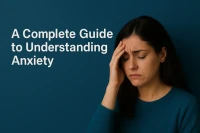
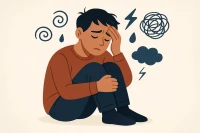
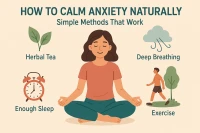

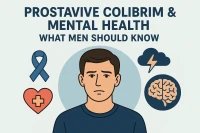
Comments